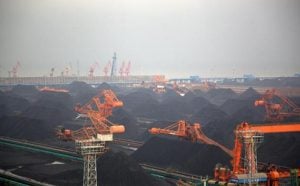They are monstrous, centuries-old infernos that issue thick billows of ash and smoke, and generate sinkholes that consume roads and homes without warning. Yet in spite of the dangers they pose, underground coal fires are some of the least known environmental disasters. China, the world’s largest miner and consumer of coal, has consistently downplayed the fires in its coalfields, considered the most severe on earth.
In some ways an underground coal fire works the same as a barbeque pit: coal is highly flammable, and stays ignited as long as there is oxygen and coal to burn. If a coalfield has an oxygen source, anything from a cigarette butt to a lightning strike can trigger a fire. Coalfields that have caught flame burn hundreds of feet underground at temperatures exceeding 1000°F for tens, hundreds, even thousands of years, rendering the surrounding area a toxic, eroded wasteland.
The ash and fumes that coal fires spew contain toxins and poisonous gases, including mercury, lead, arsenic carbon monoxide and sulphur dioxide, contaminating the air, water, and soil and causing diseases in the area’s residents. Coal fires also pump out carbon dioxide, methane, and other greenhouse gases that contribute to global warming.
Coal fires can self-ignite, but mining operations, which expose underground coal to oxygen and produce coal dust, create a much greater risk and are responsible for an estimated 75% of coal fires.
“Every country that is coal-producing has coal fires,” says Anupma Prakash, a geologist at the University of Alaska who has conducted extensive research on coal fires. So it comes as no surprise that China, which accounted for 49.5% of last year’s global coal production, also has the world’s worst coal fires. Hundreds of fires proliferate the nearly 3,000-mile coal belt running across north China.
In China, though, the main concern regarding coal fires is not environmental, but economic. “China’s coal fires destroy millions of tons of coal every year,” says Carsten Drebenstedt, a surface mining professor from Technische Universität Bergakademie Freiberg in Germany who has studied the fires. In fact, the country’s coal fires consume 20 million tons of coal annually and render ten times that amount inaccessible.
According to Prakash, “China’s coal is the best-quality coal in the world. It’s pure anthracite. So when it burns it is greater economic loss.” She estimates that the total economic loss due to coal fires and the deposits they render inaccessible is over 1.25 billion dollars.
Whether motivated by a sense of environmental conscience or economic interest, there are clear incentives to extinguish coal fires; however, the problem for firefighters is that coal fires fire can’t be seen or easily reached. “The problem is so complex and the area is so chaotic. It’s simply very, very hard to put out the fires,” explains Claudia Kuenzer, a scientist from the German Aerospace Centre.
Firefighting crews endure scalding heat and toxic fumes to put out the superficial flames, but the true enemy lies deep beneath the surface, sustained by oxygen-rich fissures in the earth. Underground fires cause the earth above them to cave in as the burning coal turns to ash, simultaneously fueling the oxygen supply and causing massive sinkholes that destroy roads and buildings. A fire consuming a coal bed moves up to two meters a month, and can easily spread to neighboring coal deposits, making it difficult to determine the flame’s source.
Extinguishing operations in China are not sophisticated—crews use bulldozers and sand or gravel to cover exposed areas and pump water and slurry underground—but the undertaking is a herculean one, requiring months or years of constant toil to completely put out a fire. It also costs millions of dollars.
Still, there is evidence that China has taken steps to address its coal fires. In the last twenty years, China has participated in two international consortiums with researchers from the Netherlands and Germany focusing on coal fire prevention, detection, and treatment. Regional governments, which previously reported coal fires as spontaneous occurrences, now extol lofty multi-million dollar plans to extinguish them.
The crisis of coal fires is nothing new in Xinjiang Province in northwest China. The region is home to Asia’s largest coal reserve and 40% of the country’s coal, as well as hundreds of underground coal fires. An official report from 2006 cited losses of over 157 million dollars each year due to the area’s coal fires. The region has been attempting to manage the fires for over fifty years, but the task poses extreme challenges for firefighters.
A government-backed project to quench the 130-year-old fire burning up the Liuhuanggou colliery in Xinjiang began in 2001. After shutting down all mining operations and spending US $16 million over the course of four years, authorities finally proclaimed the fire extinguished and erected a monument to commemorate the efforts of the firefighters.
A year later, the celebration was shown to be premature, as smoke was spotted issuing from a new fire in Liuhuanggou. The culprit? Illegal mining operations that had left the seam exposed.
Xinhua News triumphantly announced the following year that another coal fire in the area had been extinguished, writing that “Xinjiang has so far put out 34 coalfield fires and plans to extinguish another 28 by 2015.” Yet when contacted, Xinjiang coal authorities evaded interview attempts or vehemently refused to comment on the project.
Although China may not be entirely turning a blind eye to the fires, it appears its preference may be for the rest of the world to do so. Up-to-date information on the country’s coal fires is exceedingly sparse. China requires researchers to consent to confidentiality agreements that forbid them from publishing coal fire locations or plotting them on maps in detail, and refuses to release the data it collects monitoring fires outside of the country. Chinese scientists investigating the fires requested not to be named in association with their research, and one non-Chinese researcher voiced concern about not being allowed back in the country to continue to work if identified.
In 2009, Inner Mongolia launched a three-year, 25 million dollar campaign to extinguish the eighteen fires in the Wuda coalfields, historically considered the worst of the worst. Authorities cracked down on small-scale, largely illegal mining operations and ramped up efforts to put out the fires. Last year the regional government’s Disaster Management Department posted a statement online acknowledging the severity of the problem and declaring the success of ongoing firefighting operations. “After more than two years of effort, Inner Mongolia coalfield fire extinguishing projects have achieved substantial results. At present, all open flames have been extinguished.”
But researchers studying the Wuda coal fires say that not only are the fires still raging, mining operations continue alongside extinguishing efforts, causing the fires to spread deeper into the earth and triggering flare-ups of extinguished fires. “The coal fire problem in the Wuda area remains a pressing one,” they report in an article published earlier this year. “Despite large funds spent on fire extinguishing, only a few fires remain permanently extinct, while other fire areas increase in size.”
By some standards, the issue of underground coal fires may seem trivial and even futile. While 80% of China’s carbon emissions come from burning coal, the amount of those emissions from underground coal fires is miniscule in comparison with the output of the country’s coal-fired power plants, which generate twice as many CO2 emissions as the United States’. On top of that, “there are cheaper ways to cut emissions” than extinguishing coal fires, says Kuenzer, citing the enormous expense and limited resources for addressing fires in mining regions, as well as the fires’ tenacity. “The problem of coal fires will only vanish when the mineable coal is all gone,” she says.
Although putting out underground coal fires may seem a fruitless and perpetual battle, Kuenzer is optimistic that efforts to do so are not wasted. “It is better to be 50% successful than to do nothing at all,” she says. “If we were not dealing with it at all, the problem would be much more aggravated—all of the coal would be burning.” And there have been successes: the fires in two of China’s coalfields of were put out over a decade ago and have remained dormant since.
Though some support Kuenzer’s view that coal fires present a chronic battle for firefighters, others like Prakash take a different stance. “I definitely disagree that the fires are un-extinguishable,” she asserts. “There is nothing we can’t manage. We just need a solid plan.” She advocates setting up a system of constant monitoring using remote sensing to detect fires underground, and suggests it should be a priority for the Chinese government. “Establishing a monitoring system is not expensive—it is fighting coal fires that is expensive.”
The extinguishing project in Wuda is scheduled to finish this year, yet a third of the fires continue to burn. Nearly a third of the funds allocated for the project are devoted to extinguishing the remaining fires by the projected end date at the end of this year.
Given that the researchers have estimated that some parts of the Wuda coalfields can be mined for 50 more years, perhaps the more important question is if China will take measures to prevent exacerbation of current fires in their coalfields, or whether ongoing efforts will simply be band-aid solutions to a much deeper, hotter problem.







